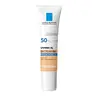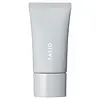La Roche-Posay Uvidea Anthelios Tinted BB Cream SPF 50+ Versus Kosé Fasio Airy Stay BB Tint UV SPF 50+
What's inside
What's inside
 Key Ingredients
Key Ingredients

 Benefits
Benefits

 Concerns
Concerns

 Ingredients Side-by-side
Ingredients Side-by-side

Water
Skin ConditioningCI 77891
Cosmetic ColorantEthylhexyl Methoxycinnamate
UV AbsorberGlycerin
HumectantDrometrizole Trisiloxane
UV AbsorberDimethicone
EmollientAlcohol Denat.
AntimicrobialTitanium Dioxide
Cosmetic ColorantTerephthalylidene Dicamphor Sulfonic Acid
UV AbsorberPropylene Glycol
HumectantDiethylamino Hydroxybenzoyl Hexyl Benzoate
UV FilterTriethanolamine
BufferingCI 77491
Cosmetic ColorantCI 77492
Cosmetic ColorantCI 77499
Cosmetic ColorantBis-Ethylhexyloxyphenol Methoxyphenyl Triazine
Skin ConditioningStearic Acid
CleansingPotassium Cetyl Phosphate
EmulsifyingPentylene Glycol
Skin ConditioningAluminum Hydroxide
EmollientBHT
AntioxidantButylene Glycol
HumectantButyrospermum Parkii Seedcake Extract
Skin ProtectingCaprylyl Glycol
EmollientCarbomer
Emulsion StabilisingCarnosine
Skin ConditioningCetyl Alcohol
EmollientDisodium EDTA
Glyceryl Stearate
EmollientMyristic Acid
CleansingMyristyl Alcohol
EmollientPalmitic Acid
EmollientPEG-100 Stearate
Phenoxyethanol
PreservativeSodium Chloride
MaskingSodium Cocoyl Sarcosinate
CleansingStearyl Alcohol
EmollientTocopherol
AntioxidantTromethamine
BufferingXanthan Gum
EmulsifyingWater, CI 77891, Ethylhexyl Methoxycinnamate, Glycerin, Drometrizole Trisiloxane, Dimethicone, Alcohol Denat., Titanium Dioxide, Terephthalylidene Dicamphor Sulfonic Acid, Propylene Glycol, Diethylamino Hydroxybenzoyl Hexyl Benzoate, Triethanolamine, CI 77491, CI 77492, CI 77499, Bis-Ethylhexyloxyphenol Methoxyphenyl Triazine, Stearic Acid, Potassium Cetyl Phosphate, Pentylene Glycol, Aluminum Hydroxide, BHT, Butylene Glycol, Butyrospermum Parkii Seedcake Extract, Caprylyl Glycol, Carbomer, Carnosine, Cetyl Alcohol, Disodium EDTA, Glyceryl Stearate, Myristic Acid, Myristyl Alcohol, Palmitic Acid, PEG-100 Stearate, Phenoxyethanol, Sodium Chloride, Sodium Cocoyl Sarcosinate, Stearyl Alcohol, Tocopherol, Tromethamine, Xanthan Gum
Water
Skin ConditioningCyclomethicone
EmollientEthylhexyl Methacrylate
Methyl Trimethicone
Skin ConditioningEthylhexyl Isononanoate
EmollientPEG-9 Polydimethylsiloxyethyl Dimethicone
EmulsifyingDiethylamino Hydroxybenzoyl Hexyl Benzoate
UV FilterEthylhexyl Palmitate
EmollientBis-Ethylhexyloxyphenol Methoxyphenyl Triazine
Skin ConditioningPolymethylsilsesquioxane
Olea Europaea Fruit Oil
MaskingSesamum Indicum Seed Oil
EmollientCarthamus Tinctorius Seed Oil
MaskingGoat Fat
Skin ConditioningJellyfish Extract
HumectantTocopherol
AntioxidantSimmondsia Chinensis Seed Oil
EmollientLimnanthes Alba Seed Oil
Skin ConditioningButylene Glycol
HumectantBHT
AntioxidantSilica Dimethicone Silylate
AbsorbentHectorite
AbsorbentSodium Stearoyl Glutamate
CleansingCetyl PEG/PPG-10/1 Dimethicone
EmulsifyingMethyl Di-T-Butyl Hydroxyhydrocinnamate
AntioxidantPentaerythritol
HumectantTriethoxycaprylylsilane
Hydrogen Dimethicone
Hydroxyapatite
AbrasivePolyisoprene
Polymethacrylic Acid
Lauryl PEG-9 Polydimethylsiloxyethyl Dimethicone
Skin ConditioningPolyglyceryl-6 Laurate
EmulsifyingLecithin
EmollientSodium Chloride
MaskingPotassium Hydroxide
BufferingHydroxylated Lecithin
EmulsifyingPhenoxyethanol
PreservativeMica
Cosmetic ColorantTitanium Dioxide
Cosmetic ColorantZinc Oxide
Cosmetic ColorantCI 77492
Cosmetic ColorantWater, Cyclomethicone, Ethylhexyl Methacrylate, Methyl Trimethicone, Ethylhexyl Isononanoate, PEG-9 Polydimethylsiloxyethyl Dimethicone, Diethylamino Hydroxybenzoyl Hexyl Benzoate, Ethylhexyl Palmitate, Bis-Ethylhexyloxyphenol Methoxyphenyl Triazine, Polymethylsilsesquioxane, Olea Europaea Fruit Oil, Sesamum Indicum Seed Oil, Carthamus Tinctorius Seed Oil, Goat Fat, Jellyfish Extract, Tocopherol, Simmondsia Chinensis Seed Oil, Limnanthes Alba Seed Oil, Butylene Glycol, BHT, Silica Dimethicone Silylate, Hectorite, Sodium Stearoyl Glutamate, Cetyl PEG/PPG-10/1 Dimethicone, Methyl Di-T-Butyl Hydroxyhydrocinnamate, Pentaerythritol, Triethoxycaprylylsilane, Hydrogen Dimethicone, Hydroxyapatite, Polyisoprene, Polymethacrylic Acid, Lauryl PEG-9 Polydimethylsiloxyethyl Dimethicone, Polyglyceryl-6 Laurate, Lecithin, Sodium Chloride, Potassium Hydroxide, Hydroxylated Lecithin, Phenoxyethanol, Mica, Titanium Dioxide, Zinc Oxide, CI 77492
 Reviews
Reviews

Ingredients Explained
These ingredients are found in both products.
Ingredients higher up in an ingredient list are typically present in a larger amount.
BHT is a synthetic antioxidant and preservative.
As an antioxidant, it helps your body fight off free-radicals. Free-radicals are molecules that may damage your skin cells.
As a preservative, it is used to stabilize products and prevent them from degrading. Specifically, BHT prevents degradation from oxidation.
The concerns related to BHT come from oral studies; this ingredient is currently allowed for use by both the FDA and EU.
However, it was recently restricted for use in the UK as of April 2024.
Learn more about BHTYou might know this ingredient as Tinosorb S or Bemotrizinol. It is a UV filter that covers both UVA and UVB rays.
This ingredient has two peak UV absorption peaks ( 310 and 340 nm) and is able to absorb both UV-A and UV-B rays. This ingredient works by preventing UV rays from reaching and damaging your skin.
On top of that - it is highly photostable and helps prevent the photodegration of other sunscreen ingredients such as avobenzone.
Tinosorb S is allowed in the EU, Australia, and Asia. It is close to being approved by the FDA and we'll hopefully get this ingredient in the U.S. by late 2025.
Fun fact: Tinosorb S is the most effective UV absorber at maximum concentration (measured by SPF) permitted in the EU.
This ingredient is oil-soluble, so your oil-cleansers will take this right off at night.
Learn more about Bis-Ethylhexyloxyphenol Methoxyphenyl TriazineButylene Glycol (or BG) is used within cosmetic products for a few different reasons:
Overall, Butylene Glycol is a safe and well-rounded ingredient that works well with other ingredients.
Though this ingredient works well with most skin types, some people with sensitive skin may experience a reaction such as allergic rashes, closed comedones, or itchiness.
Learn more about Butylene GlycolCi 77492 is also hydrated iron III oxide. It's sole purpose is to give a yellow hue to products.
Iron III oxides are classified as inorganic chemicals for coloring.
Synthetically created Ci 77492 is considered safer than those naturally found. This is because the synthetically created version may contain less impurities. Iron oxides are generally non-toxic and non-allergenic.
Learn more about CI 77492Diethylamino Hydroxybenzoyl Hexyl Benzoate (DHHB) is a chemical UV-A absorber. It is formulated for high UVA protection (320-400 nm).
DHHB is well-liked for:
DHHB has been approved by the EU, Japan, Taiwan, and South America for use up to 10%. Unfortunately, it has not been approved for use in the US or Canada due to slow regulatory processes.
This ingredient is soluble in oils, fats, and lipids.
Learn more about Diethylamino Hydroxybenzoyl Hexyl BenzoatePhenoxyethanol is a preservative that has germicide, antimicrobial, and aromatic properties. Studies show that phenoxyethanol can prevent microbial growth. By itself, it has a scent that is similar to that of a rose.
It's often used in formulations along with Caprylyl Glycol to preserve the shelf life of products.
Chances are, you eat sodium chloride every day. Sodium Chloride is also known as table salt.
This ingredient has many purposes in skincare: thickener, emulsifier, and exfoliator.
You'll most likely find this ingredient in cleansers where it is used to create a gel-like texture. As an emulsifier, it also prevents ingredients from separating.
There is much debate on whether this ingredient is comedogenic. The short answer - comedogenic ratings don't tell the whole story. Learn more about comegodenic ratings here.
The concensus about this ingredient causing acne seems to be divided. Research is needed to understand if this ingredient does cause acne.
Scrubs may use salt as the primary exfoliating ingredient.
Learn more about Sodium ChlorideTitanium dioxide is a mineral UV filter widely used in sunscreens and cosmetics.
It is one of only two UV filters officially classified as “mineral” by regulatory agencies, the other being zinc oxide.
Titanium dioxide provides broad-spectrum protection mostly in the UVB and UVAII range, with some protection in the UVAI range.
While its UVA protection isn’t as strong as zinc oxide’s, the difference is minor.
A common myth is that mineral UV filters reflect UV light. However, modern research shows titanium dioxide absorbs UV radiation like chemical filters (~95% absorption & 5% reflection).
Thanks to its non-irritating nature, titanium dioxide is suitable for sensitive, acne-prone, or redness-prone skin. It is unlikely to cause "eye sting" like other sunscreen ingredients.
A major drawback of this ingredient is its white cast and thick texture. This is why mineral sunscreens often leave a white cast and are less cosmetically elegant than chemical/hybrid sunscreens.
To improve white cast and spreadability, micronized or nano-sized titanium dioxide is often used.
There are ongoing concerns surrounding nano-titanium oxide's impact on marine ecosystems.
There is no conclusive evidence that any form of titanium oxide (or any other sunscreen ingredients) will cause harm to marine ecosystems or coral reefs. The science is still developing but many consumers are keeping a close eye on this issue.
Please note, many destinations have reef-safety sunscreen rules. For instance, the U.S. Virgin Islands advises all visitors to use non-nano mineral sunscreens.
Nano mineral sunscreens once raised safety concerns about absorption into skin.
Extensive research has shown that they do not penetrate healthy or damaged skin; they remain safely on the surface and the top layer of dead skin (stratum corneum).
You'll likely find titanium dioxide bundled with alumina, silica, or dimethicone. These ingredients help make titanium dioxide highly photostable; this prevents it from interacting with other formula components under UV light.
Learn more about Titanium DioxideTocopherol (also known as Vitamin E) is a common antioxidant used to help protect the skin from free-radicals and strengthen the skin barrier. It's also fat soluble - this means our skin is great at absorbing it.
Vitamin E also helps keep your natural skin lipids healthy. Your lipid skin barrier naturally consists of lipids, ceramides, and fatty acids. Vitamin E offers extra protection for your skin’s lipid barrier, keeping your skin healthy and nourished.
Another benefit is a bit of UV protection. Vitamin E helps reduce the damage caused by UVB rays. (It should not replace your sunscreen). Combining it with Vitamin C can decrease sunburned cells and hyperpigmentation after UV exposure.
You might have noticed Vitamin E + C often paired together. This is because it is great at stabilizing Vitamin C. Using the two together helps increase the effectiveness of both ingredients.
There are often claims that Vitamin E can reduce/prevent scarring, but these claims haven't been confirmed by scientific research.
Learn more about TocopherolWater. It's the most common cosmetic ingredient of all. You'll usually see it at the top of ingredient lists, meaning that it makes up the largest part of the product.
So why is it so popular? Water most often acts as a solvent - this means that it helps dissolve other ingredients into the formulation.
You'll also recognize water as that liquid we all need to stay alive. If you see this, drink a glass of water. Stay hydrated!
Learn more about Water